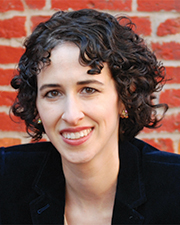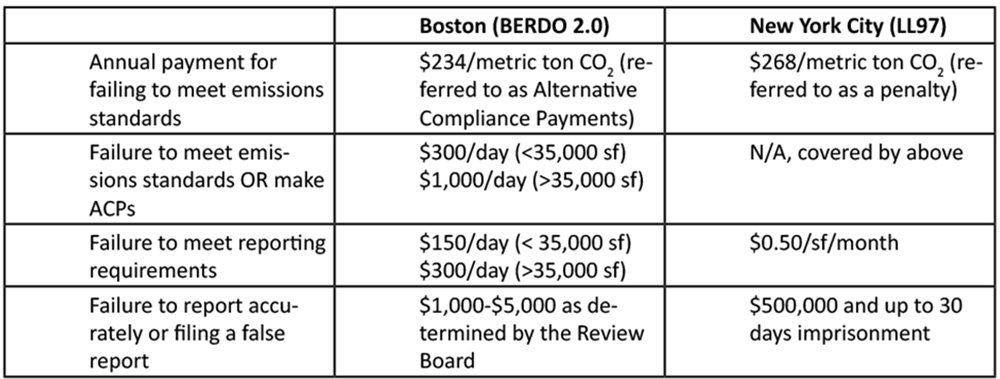
This is the second article in a three-part series. For the first article, please see the March 4 edition of NEREJ.
In this article we’ll review fundamental strategies to meet carbon emissions standards compared to the costs of non-compliance with New York’s Local Law 97 (LL97) and Boston’s Building Emissions Reduction and Disclosure Ordinance (BERDO 2.0). The first step is to evaluate current building performance. AKF has developed online tools that retrieve and graph publicly reported energy use data, compare it to LL97 and BERDO 2.0 carbon emissions standards, and display estimated penalties/payments for upcoming and future compliance periods. LL97: https://www.be-exchange.org/calculator/.BERDO 2.0: https://akf-berdo-calculator.herokuapp.com/.
While new construction design teams can often look to successful net zero examples by building type, the best solutions for existing buildings vary widely and are often subject to many constraints and challenges, including high costs, disruption of current building operation, and desire to preserve historical structures. However, there are overarching principals that can be identified and prioritized by energy audits and retro-commissioning.
Reduce building loads: Outside of high-ventilation laboratory/healthcare facilities, improvements to envelope thermal performance and airtightness have the largest impact on meeting carbon standards by allowing reduction or elimination of fossil fuel-based space heating. Though the electric grid is being decarbonized over time, envelope improvements also reduce fan and cooling electricity use. Lighting loads can be reduced and controls installed. Facilities should scrutinize high loads such as those from kitchens and data centers for controls and replacement opportunities.
Upgrade and electrify HVAC Systems: Investigate efficiency and controls of HVAC equipment to identify energy conservation measures. Consider the feasibility of reducing or eliminating fossil fuel use on site to take advantage of electric grid decarbonization.
Evaluate District Utility Use: Buildings with infrastructure connecting to district utilities have many considerations. While there are plans in both NYC and Boston to aggressively decarbonize electric grids, fossil fuel use will have a relatively constant carbon impact over time, making it difficult for buildings purchasing chilled water or steam generated using fossil fuels to reach emissions standards. However, some district utilities such as Con Edison and Vicinity Energy are developing decarbonization plans including eventual supply of zero carbon steam (generated using electricity from renewable sources).
Leverage utility incentives: Boston and New York both offer generous incentives through Mass Save and Con Edison/NYSERDA, including funding for energy studies and design team incentives.
In addition to installation of on-site renewable energy, both LL97 and BERDO 2.0 will allow emissions standards to be met with power purchase agreements and Renewable Energy Certificates (RECs) meeting the requirements of NYISO/ MA Class I. As emissions standards decrease, almost all buildings will require REC purchases; most applicable buildings are multi-story with little PV-ready roof area available. Unlike BERDO 2.0, LL97 also allows the purchase of approved carbon offsets (10% maximum in the first reporting period only).

For buildings that do not meet emissions targets, Boston and New York have put similar prices on carbon above allowances ($234 and $268 per metric ton, respectively, subject to change in future compliance periods). These are referred to as Alternative Compliance Payments (ACPs) by BERDO 2.0 and penalties by LL97. BERDO 2.0 penalties and ACPs will be directed to the Equitable Emissions Investment Fund for allocation to various carbon abatement projects prioritizing affordable housing, air quality improvement, green jobs training, and MWDBE assistance. Penalties in NYC are currently directed back to the city with no specific usage yet defined. Other costs for failing to report, filing false reports, and in the case of BERDO 2.0, daily penalties for exceeding carbon standards while neglecting to pay ACPs are summarized in the table above.
BERDO 2.0 also includes guidelines for portfolios and campuses, which may apply for blended emissions standards. If certain campus buildings achieve performance superior to a particular year’s standards while others fall short, this approach reduces the organization’s total ACPs. Similar accounting is referenced in LL97 for NYC.
While each project is unique, energy audits, retro-commissioning, and a thorough understanding of compliance options will empower building owners to select the most cost-effective paths. In the next article we’ll explore several existing building examples and pathways through the use of AKF’s online tools referenced/linked above.
Roselin Osser, PE, BEMP, LEED AP is a senior engineer with AKF’s Energy + Performance team.
 (1).png)







